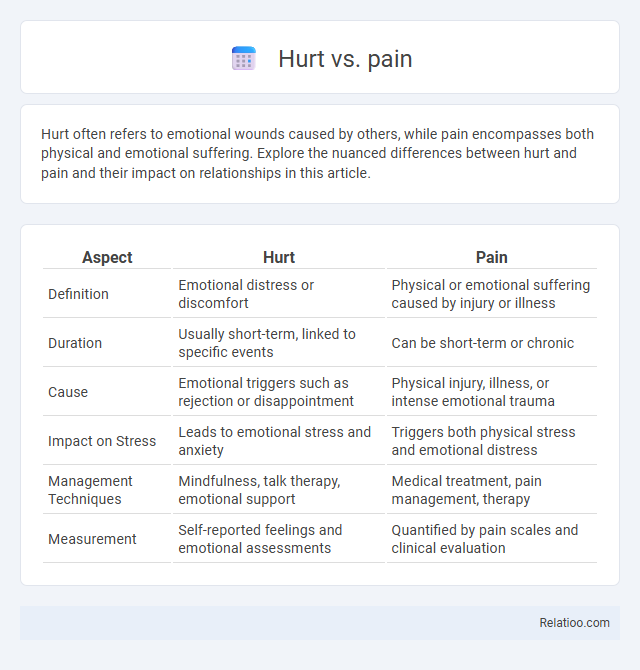Hurt often refers to emotional wounds caused by others, while pain encompasses both physical and emotional suffering. Explore the nuanced differences between hurt and pain and their impact on relationships in this article.
Table of Comparison
| Aspect | Hurt | Pain |
|---|---|---|
| Definition | Emotional distress or discomfort | Physical or emotional suffering caused by injury or illness |
| Duration | Usually short-term, linked to specific events | Can be short-term or chronic |
| Cause | Emotional triggers such as rejection or disappointment | Physical injury, illness, or intense emotional trauma |
| Impact on Stress | Leads to emotional stress and anxiety | Triggers both physical stress and emotional distress |
| Management Techniques | Mindfulness, talk therapy, emotional support | Medical treatment, pain management, therapy |
| Measurement | Self-reported feelings and emotional assessments | Quantified by pain scales and clinical evaluation |
Understanding the Difference: Hurt vs Pain
Understanding the difference between hurt and pain involves recognizing that pain refers to a physical or emotional sensation signaling damage or distress, while hurt emphasizes the emotional or psychological impact of that sensation. You may experience pain as a direct response to injury or illness, whereas hurt captures the deeper feeling of being emotionally wounded or upset. Differentiating these terms helps in accurately expressing your physical discomfort versus your emotional suffering.
Defining Hurt: Emotional and Physical Contexts
Hurt encompasses both emotional and physical experiences, representing a state of suffering or distress caused by injury or emotional wound. It differs from pain, which refers specifically to the sensory experience often linked to physical damage, while hurt captures the broader impact on your feelings and overall well-being. Understanding hurt involves recognizing its dual nature in affecting your mental state and physical condition simultaneously.
What is Pain? Medical and Psychological Perspectives
Pain is a complex sensory and emotional experience signaling actual or potential tissue damage, involving both physical and psychological components. Medically, pain is categorized as acute or chronic, with nociceptors transmitting signals to the brain, while psychologically, pain perception is influenced by emotions, past experiences, and cognitive factors. Understanding your pain requires integrating these medical and psychological perspectives to effectively address its impact on overall well-being.
Causes of Hurt: External vs Internal Factors
Hurt arises from external factors such as physical injury or emotional betrayal, while pain often signals an internal response linked to tissue damage or psychological distress. Your experience of hurt can stem from internal factors like unresolved guilt or anxiety that amplify emotional suffering beyond physical causes. Understanding the distinct origins of hurt and pain helps target effective healing strategies by addressing both external triggers and internal emotional states.
Types of Pain: Acute, Chronic, and Emotional
Acute pain is a sharp, sudden sensation signaling injury or illness requiring immediate attention, while chronic pain persists for months, often without a clear cause, affecting daily life and mental health. Emotional pain arises from psychological stress, loss, or trauma, deeply impacting your overall well-being and resilience. Understanding these types of pain helps in identifying appropriate treatment strategies for physical and emotional recovery.
How Hurt Manifests in Daily Life
Hurt manifests in daily life as emotional distress, often triggered by interpersonal conflicts or feelings of rejection, leading to symptoms such as sadness, withdrawal, or irritability. Physical hurt, unlike emotional hurt, involves actual bodily injury or discomfort caused by trauma, accidents, or chronic conditions. Pain encompasses both physical sensations and emotional suffering, serving as a complex signal that impacts behavior and well-being.
How Pain Impacts the Body and Mind
Pain triggers complex physiological and psychological responses impacting both body and mind; it activates the nervous system, releases stress hormones, and can lead to inflammation and tissue damage. Chronic pain alters brain structure and function, contributing to anxiety, depression, and cognitive difficulties, affecting your overall well-being and daily functioning. Understanding how pain influences these interconnected systems is crucial for effective management and healing strategies.
Coping Mechanisms for Hurt and Pain
Hurt and pain often manifest emotionally and physically, requiring distinct coping mechanisms tailored to your specific experience. Coping with hurt involves acknowledging emotional wounds through self-reflection, expressing feelings openly, and seeking social support to foster healing. Managing physical pain relies on medical interventions, physical therapy, and mindfulness techniques to reduce discomfort and improve overall well-being.
Healing and Recovery: From Hurt to Health
Hurt represents emotional or physical injury that initiates the healing process, while pain signals the body's natural response to trauma requiring care for recovery. Healing involves repairing tissues and restoring emotional balance through time, therapy, and self-care strategies that transform hurt into health. Recovery depends on addressing underlying causes of pain and hurt, fostering resilience and wellness through targeted treatments and supportive environments.
When to Seek Help: Recognizing Serious Hurt or Pain
Severe or persistent hurt and pain signals the need for professional medical evaluation to prevent complications or underlying conditions. You should seek help if the pain worsens, is accompanied by swelling, numbness, or unexplained bruising, or if it interferes with daily activities or sleep. Early assessment ensures appropriate diagnosis and treatment, reducing the risk of chronic issues or long-term damage.

Infographic: Hurt vs Pain
 relatioo.com
relatioo.com